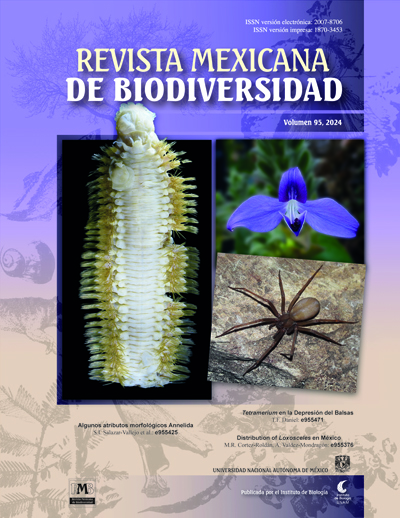New state records of Bromeliaceae and Piperaceae in Mexico
DOI:
https://doi.org/10.22201/ib.20078706e.2024.95.5346Keywords:
Urban green areas, Montane cloud forest, Pseudalcantarea, Piper, Tillandsia, WerauhiaAbstract
The flora of Mexico is constantly updated, and the Bromeliaceae and Piperaceae families are represented in the country with numerous species, mainly in the southern states. However, botanical explorations have increased the
species reported for each state, and some can be found by studying herbaria and misidentified specimens, or relict
forests close to urban areas. This work aims to report new records of Bromeliaceae and Piperaceae for different
Mexican states, an updated distribution map in Mexico. Between 2018 and 2023, as part of different botanical
explorations, including peri-urban green areas, specimens were collected and identified using identification keys and
experts’ help. We determined new contributions to state floras and northern extensions to the known distribution of
these species, one of which was present in urban forest remnants. The four new records correspond to Pseudalcantarea macropetala, Tillandsia heterophylla, Werauhia nutans, and Piper pseudoasperifolium from montane cloud forests and secondary vegetation, demonstrating the importance of carrying out botanical explorations in different types of vegetation, also considering forest remnants in urban areas.
References
Aguilar-Rodríguez, P. A., Díaz-Jiménez, P., Espejo-Serna, A., López-Ferrari, A. R., Hentrich, H., Yovel, Y. et al. (2020). A new Werauhia (Tillandsioideae, Bromeliaceae) from Mexico with observations about its reproductive biology. Phytotaxa, 446, 128–134. https://doi.org/10.11646/phytotaxa.446.2.6
Aguilar-Rodríguez, P. A., Krömer, T., García-Franco, J. G. y MacSwiney G., M. C. (2016). From dusk till dawn: nocturnal and diurnal pollination in the epiphyte Tillandsia heterophylla (Bromeliaceae). Plant Biology, 18, 37–45. https://doi.org/10.1111/plb.12319
Aguilar-Rodríguez, P. A., MacSwiney G., M. C., Krömer, T., García-Franco, J. G., Knauer, A. y Kessler, M. (2014). First record of bat-pollination in the species-rich genus Tillandsia (Bromeliaceae). Annals of Botany, 113, 1047–1055. https://doi.org/10.1093/aob/mcu031
Aguilar-Rodríguez, P. A., Tschapka, M., García-Franco, J. G., Krömer, T. y MacSwiney G., M. C. (2019). Bromeliads going batty: pollinator partitioning among sympatric chiropterophilous Bromeliaceae. AoB Plants, 11, 1–19. https://doi.org/10.1093/aobpla/plz014
Barfuss, M. H. J., Till, W., Leme, E. M. C., Pinzón, J. P., Manzanares, J. M., Halbritter, H. et al. (2016). Taxonomic revision of Bromeliaceae subfam. Tillandsioideae based on a multi-locus DNA sequence phylogeny and morphology. Phytotaxa, 279, 1–97. https://doi.org/10.11646/phytotaxa.279.1.1
Benzing, D. H. (2000). Bromeliaceae. Profile of an adaptive radiation. Cambridge, RU: Cambridge University Press.
Callejas-Posada, R. (2020). Piperaceae. En G. Davidse, C. Ulloa-Ulloa, H. M. Hernández-Macías y S. Knapp (Eds.), Flora Mesoamericana (pp. 1–590). Missouri Botanical Garden, St. Louis. Disponible en: http://www.udea.edu.co/wps/wcm/connect/udea/1f3edff1-8eef-4d0f-954a-4c77d5d4eb75/Piperaceae_flora_meso_compressed.pdf?MOD=AJPERESetCVID=obVwDyZ
Espejo-Serna, A. y López-Ferrari, A. R. (2004). Notas sobre la familia Bromeliaceae en el Valle de México. Acta Botanica Mexicana, 67, 49–57. https://doi.org/10.21829/abm67.2004.973
Espejo-Serna, A., López-Ferrari, A. R. y Ramírez-Morillo, I. (2005). Bromeliaceae. Flora de Veracruz. Fascículo 136. Xalapa: Instituto de Ecología, A.C.
Espejo-Serna, A., López-Ferrari, A. R., Martínez-Correa, N. y Pulido Esparza, V. A. (2007). Bromeliad flora of Oaxaca, Mexico: Richness and distribution. Acta Botanica Mexicana, 81, 71–147. https://doi.org/10.21829/abm81.2007.1025
Espejo-Serna, A., López-Ferrari, A. R., Mendoza-Ruiz, A., García-Cruz, J., Ceja-Romero, J. y Pérez-García, B. (2021). Mexican vascular epiphytes: richness and distribution. Phytotaxa, 503, 001–124. https://doi.org/10.11646/phytotaxa.503.1.1
Krömer, T., Espejo-Serna, A., López-Ferreri, A. R., Ehlers, R. y Lautner, J. (2012). Taxonomic and nomenclatural status of the Mexican species in the Tillandsia viridiflora complex (Bromeliaceae). Acta Botanica Mexicana, 99, 1–20. https://doi.org/10.21829/abm99.2012.16
Morrone, J., Espinosa-Organista, D. y Llorente-Bousquets, J. (2002). Mexican biogeographic provinces: preliminary scheme, general characterizations, and synonymies. Acta Zoológica Mexicana, 85, 83–108. https://doi.org/10.21829/azm.2002.85851814
Quijano-Abril, M. A., Callejas-Posada, R. y Miranda-Esquivel, D. R. (2006). Areas of endemism and distribution patterns for Neotropical Piper species (Piperaceae). Journal of Biogeography, 33, 1266–1278. https://doi.org/10.1111/j.1365-2699.2006.01501.x
Samain, M. S. y Tebbs, M. C. (2020). Piperaceae. Flora del Bajío y de Regiones Adyacentes, 215, 1–62.
Tebbs, M. C. (1993). Revision of Piper in the new in the New World. 3. The taxonomy of Piper sections Lepiantes and Radula. Bulletin of the Natural History Museum of London, 23, 1-50.
Thiers, B. (2016) Index Herbariorum. A global directory of public herbaria and associated staff. New York Botanical Garden`s virtual herbarium. https://sweetgum.nybg.org/science/ih/
Tobías-Baeza, A., Salvador-Morales, P., Sánchez-Hernández, R., Ruiz-Acosta, S. C., Arrieta-Rivera, A. y Andrade-Prado, H. (2019). Composición florística y carbono en la vegetación arbórea de un área periurbana en Tabasco, México. Ecosistemas y Recursos Agropecuarios, 6, 369–376. https://doi.org/10.19136/era.a6n17.2009
Torres-Colín, R., Parra, J. G., de la Cruz, L. A., Ramírez, M. P., Gómez-Hinostrosa, C., Bárcenas, R. T. et al. (2017). Flora vascular del municipio de Guadalcázar y zonas adyacentes, San Luis Potosí, México. Revista Mexicana de Biodiversidad, 88, 524–554. https://doi.org/10.1016/j.rmb.2017.07.003
TROPICOS. (2022a). Missouri Botanical Garden. Recuperado el 10 de septiembre de 2022 de: https://www.tropicos.org/home
UNAM (Universidad Nacional Autónoma de México). (2022). Portal de Datos Abiertos UNAM. Recuperado el 01 de septiembre de 2022 de: https://datosabiertos.unam.mx/biodiversidad/
Vargas-Rueda, A. F., Rivera-Hernández, J. E., Cházaro-Basáñez, M. J. y Alcántara-Salinas, G. (2019). Nuevos registros para la flora de Veracruz en el Parque Nacional Cañón del Río Blanco, México. Acta Botanica Mexicana, 126, e1429. https://doi.org/10.21829/abm126.2019.1429
Villaseñor, J. L. (2010). El bosque húmedo de montaña en México y sus plantas vasculares. Catálogo florístico taxonómico. Ciudad de México: Conabio/ UNAM.
Villaseñor, J. L. (2016). Checklist of the native vascular plants of Mexico. Revista Mexicana de Biodiversidad, 87, 559–902. https://doi.org/10.1016/j.rmb.2016.06.017
Villaseñor, J. L., Ortiz, E., Sánchez-González, A. (2022). Riqueza y distribución de la flora vascular del estado de Hidalgo, México. Revista Mexicana de Biodiversidad, 93, e933920. https://doi.org/10.22201/ib.20078706e.2022.93.3920
Zotz, G. (2013). The systematic distribution of vascular epiphytes —a critical update. Botanical Journal of the Linnean Society, 171, 453–481. https://doi.org/10.1111/boj.12010




